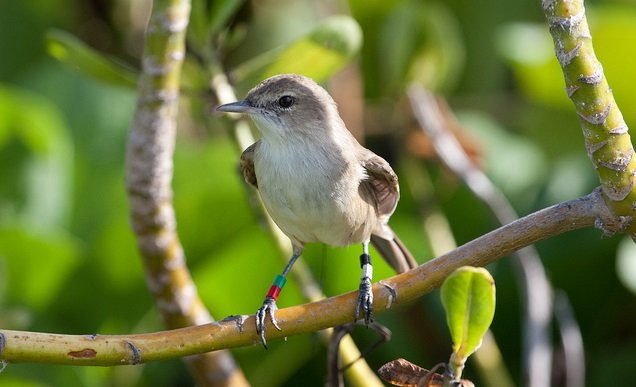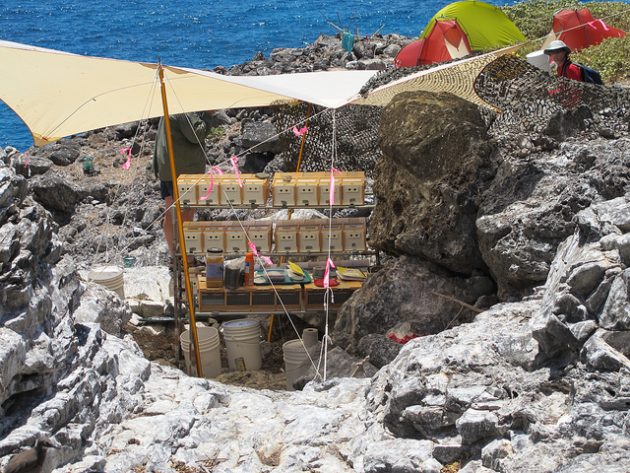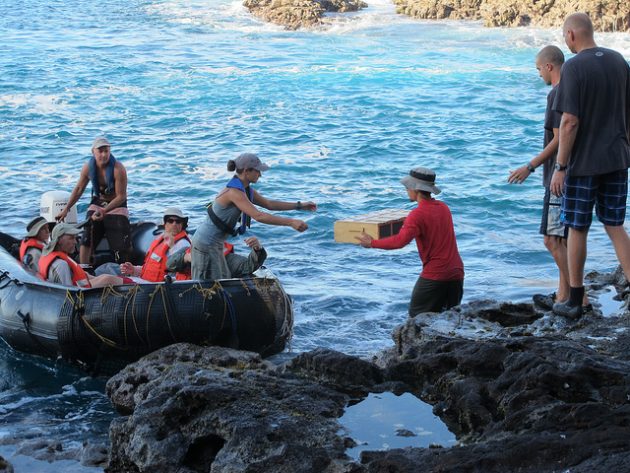
In addition to my monthly posts here, I have also written short pieces and feature articles that rely on bird-related scientific literature. My impression is that few birders dive into ornithological and ecological papers, but there’s much to be learned, even if the reading can be tough sledding. This post provides a quick overview of how a birder might approach that task.
It is helpful to have a sample paper. Several years ago, I read about the enormous colonies of breeding birds in the Northwestern Hawaiian Islands and I did some research to satisfy my curiosity. (Google Scholar is an excellent resource and free full-text PDFs can be located for many papers, particularly when research is taxpayer-funded. Other papers are locked behind paywalls.) That research ultimately led to an article about the conservation efforts regarding the Laysan Duck in the June 2017 issue of Birding.
One of the sidebars in that article provided a short summary of the translocation of the Millerbird. That summary was based in part on this paper:
Freifeld, Holly B., et al. “Long-distance translocations to create a second millerbird population and reduce extinction risk.” Biological Conservation 199 (2016): 146-156. (Link.)
I selected this paper because it is unusually accessible (for example, it does not have formal modeling, genetic analysis, or daunting equations) and tells a fascinating story about shipping tiny birds hundreds of miles between two isolated islands in the remote Pacific Ocean. It is also well-written and seems likely to be of interest to a conservation-minded birder.
# # #
Initially, scientific papers are written by scientists for other scientists. They are intended to convey detailed information in the precise technical language and jargon familiar to the intended audience. These papers are not light reading and are decidedly not intended to be entertaining page-turners. Indeed, to the extent some personality might have once existed in a draft, editors and peer reviewers appear to ruthlessly stomp it out. It is all business.
It takes some time for non-scientists to wade through the language. For example, fancy words will be used where normal words might seem appropriate: birds of the same species are “conspecifics” (and they will never, ever “flock together”).
Papers almost invariably follow a version of the same formal structure: (1) introduction; (2) methods; (3) results; (4) discussion; (5) conclusion.
To a layperson, this means: (1) relatively accessible introduction to the topic that includes useful citations to the literature; (2) soul-deadening hyper-detailed description of the way the research was conducted, often down the the brand of reagents; (3) exhaustive accounting of the resulting data; (4) relatively accessible discussion of the results, with some context; and (5) tentative summary of conclusions and topics for further research. Much of the time, a quick review of the “introduction” and “discussion” is all that is needed. (My impression is that this is generally true for scientists too.)
At the front of most papers is a dense abstract that nominally provides a summary of the paper, though many unsuccessfully attempt to balance the incompatible goals of brevity and detail, rendering its utility hit-or-miss. And the end, there is typically a list of references, a helpful resource for further research.

Let’s look at our paper, which is blandly titled: “Long-distance translocations to create a second millerbird population and reduce extinction risk.” The scientific literature does not seek creativity or levity in titles — academic journals are not the New York Post. You will not see puns or alliteration or anything resembling wit.
The “introduction” is a readable summary of translocating birds to establish new populations to reduce extinction risk, with extensive citations to literature. The citations are mid-sentence and enclosed by parentheses, but the eye learns to skip over them, so they are not an undue distraction. The section also describes the ecological history and current state of the Northwestern Hawaiian islands and gives background about the Millerbird.
Broadly speaking, the Nihoa subspecies of Millerbird is a single-island endemic, so it is particularly susceptible to catastrophic storms and the like. As a result, the Millerbird would be more resilient if it were on more islands. That way, if a devastating storm hit one island, there would still be Millerbirds on other islands. Since Laysan once had a different subspecies of Millerbird (now extinct) and has a similar habitat, Laysan was a good candidate for translocation.
The “methods” section explains in detail the procedures and processes used to translocate to birds from Nihoa to Laysan, including assessments of the food supply on Laysan, development of techniques to physically transport the birds, assessing the impact of removing some of Millerbirds from the population on Nihoa, capturing and transporting the birds, and monitoring the translocated birds. The details can be truly granular: the “Holohil™ LB-2N transmitters with mortality sensors” were attached to the birds with “OstoBond™.”
The “results” section summarizes the outcomes. Over two years (2011 and 2012), scientists captured 50 birds and successfully transported them from Nihoa to Laysan. No birds died during the translocation and the one-year survival rate was 58% in the 2011 and 96% in the 2012. By September 2014, there were an estimated 164 Millerbirds on Laysan.
The “discussion” section steps back and provides additional context and the “conclusions” section identifies some of the reasons for the success of the program (e.g., years-long preparations and research), challenges (e.g., climate change), and speculates about future translocations within the Northwestern Hawaiian Islands.
The entire paper is worth reading and the story is fascinating:
To the best of our knowledge this translocation was among the most logistically challenging ever undertaken with small insectivorous passerines, involving capturing birds in a remote, rugged location; safely moving them off Nihoa’s wave-washed landing site; and maintaining them in captivity for several days on Nihoa and three days at sea.
The photos are from the USFWS Flickr album of the initial translocation in 2011.

For some contrast, let’s also look at a more technical paper. Some background: a translocation program should maintain as much of the source population’s genetic diversity as possible. Thus, one issue is the number of birds that should be be successfully translocated to encompass most or all of that diversity.
The Millerbird source population on Nihoa was tiny and such populations tend to be subject to bottlenecks that limit genetic diversity. Data is needed to make estimates for the optimal size of the translocated group. This paper, which was cited in the paper we just discussed, conducted the relevant experiments:
Addison, Jason A., and Antony W. Diamond. “Population genetics and effective population size of the critically endangered Nihoa Millerbird (Acrocephalus familiaris kingi).” The Auk 128.2 (2011): 265-272. (Link)
This paper is much less accessible to a layperson. The methods section is incomprehensible, as is much of the rest of the paper. (Again, birders are not the intended audience.) But the essence can be distilled in just a few lightly edited sentences taken from introduction and discussion sections:
The Nihoa Millerbird is a critically endangered species, and plans to increase its population and reduce the potential for extinction include the translocation from Nihoa to Laysan Island. Detailed knowledge of the genetic diversity in this species will help inform the effort by analyzing genetic variation in the source population. Our results reveal strikingly low levels of diversity in the Nihoa Millerbird. As a result, targeting as few as 8 to 13 individuals for translocation could preserve the genetic diversity. To be safe, we suggest that the number of individuals targeted for translocation should be between 20 and 40.
Even without a scientific background, a few minutes with this paper might be worthwhile to a motivated birder interested in Millerbird translocation, if only to discover that the genetic diversity of an entire subspecies might be captured in as few as eight birds.
# # #
The translocation of the Millerbird is a fascinating story of avian conservation (learn more here and here and here) and if you want the details about how the project was conducted, the scientific literature is likely the most complete and accurate source.

Photos: “Nihoa Millerbirds 1st Translocation to Laysan Island” by USFWS – Pacific Region.












Although the bulk of academic literature is written in a fairly dry, serious manner, moments of levity are not rare, let alone absent, in scientific papers. A recent paper describing a new snake species has quite the alliteration game going on in its title, and that’s tame compared to the Paradise Lost/Paradise Regained reference in this paper on the evolution of primate lice. More examples (some intentional, others not) can be found collected on this blog. (Disclaimer: I am one of the curators of said blog.)
Great article, Jason. I look though one of The Auk’s research articles periodically, for a change of pace and to keep in touch with academia-talk. Usually, as you recommend, I read the abstract, introduction, literature review, then skim the rest because methodology makes my head spin. I also find the research topics interesting in their fine-toned specificity.
Hey Jason,
Thanks for your post about reading scientific literature. I just want to add that there are many regional or state-based avian reaearch journals that have articles that are often more accessible to non-scientists than those in the hard-core science journals. An example is Maryland Birdlife, published by the Maryland Ornithological Society (disclaimer: my husband, Gene Scarpulla, is the editor). Many of these regional journals, as well as the venerable Auk and Condor, can be accessed through SORA, the Searchable Ornithological Research Archive, hosted by the University of New Mexico at https://sora.unm.edu.
I often read journals for a better understanding of many topics. I find the abstract and conclusion to contain most of the info I need. Also, Ms. Marcia is correct, local ornithological societies often publish free access journals that are easier to digest.
Louisiana ornithological society is one I read regularly. Thanks for the post!